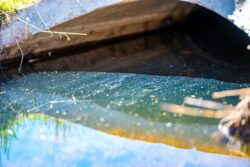Stopping the Flow: How to Prevent Storm Water Pollution and Protect Our Waterways
 Stopping the Flow: How to Prevent Storm Water Pollution and Protect Our Waterways
Stopping the Flow: How to Prevent Storm Water Pollution and Protect Our Waterways
Stormwater is a significant source of water pollution, with uncontrolled runoff carrying various pollutants and debris such as pesticides, fertilizers, trash, sediment, and pet waste into water bodies such as rivers, lakes, and oceans. To reduce the impact of stormwater on our waterways, it is essential to manage and control runoff. In this blog, we will discuss how to prevent stormwater pollution, and how our actions can protect our waterways.
1. Reduce Chemical Use
Chemicals like fertilizers, pesticides, and herbicides used in gardening and agriculture, and oil and grease from cars, are significant contributors to stormwater pollution. One way to prevent runoff pollution is to reduce the amount of chemicals we use in our daily activities. Whenever possible, use organic and non-toxic products for gardening, and dispose of hazardous chemicals properly.
2. Proper Garbage Disposal
Improperly discarded trash makes its way into storm drains and eventually into our waterways, carrying toxic pollutants and debris that can harm aquatic life. If you have litter on your property, make sure it’s disposed of in trash cans or recycling bins to ensure it doesn’t become runoff. Never dispose of hazardous materials like batteries, electronics, and paints in the trash.
3. Mindful Car Maintenance
Cars are a significant source of pollutants in stormwater runoff. Brake dust, engine oil, and other fluids from cars contribute significantly to pollution in our waterways. Regular vehicle maintenance, such as fixing leaks and getting oil changes, will help prevent these pollutants from reaching our waterways.
4. Create a Rain Garden
A rain garden is a shallow basin with native plants that helps absorb and filter stormwater runoff. These gardens are designed to capture runoff from roofs, sidewalks, and driveways and filter it through the soil, which is an effective way to prevent pollution from reaching our waterways. Rain gardens also help mitigate the risk of flooding and erosion in urban areas.
5. Utilize Permeable Pavement
Permeable pavement is an alternative to traditional concrete or asphalt paving. It is designed to allow water to pass through, reducing the amount of runoff and filtering pollutants before they enter the ground. This pavement can be used for driveways, sidewalks, and parking lots, reducing the stress on storm drains and mitigating the risk of flooding.
6. Install a Rain Barrel
A rain barrel is a container that is placed underneath a downspout to collect and store rainwater. The collected water can then be used for irrigation or other non-potable purposes. This not only helps prevent runoff pollution, but also conserves water use, helping protect and preserve our water resources.
7. Build or Maintain Retention Ponds
Retention ponds are designed to hold and filter stormwater runoff. They help reduce the volume and velocity of runoff, allowing for pollutants to settle at the bottom. These wetland areas can be designed to mimic a natural habitat, allowing plants to grow and helping to absorb excess water. Maintenance of these ponds is essential to prevent them from becoming overgrown or filled with sediment that could potentially contaminate the water.
Final Thoughts
Preventing stormwater pollution is a critical step in protecting our waterways. By implementing the methods mentioned above, we can help reduce the volume and impact of stormwater runoff and create a healthier environment for ourselves and our aquatic life. Implementing these steps can help the environment and the community. By working together, we can create a healthy and beautiful environment for generations to come.
Categorised in: Stormwater Pollution Prevention
